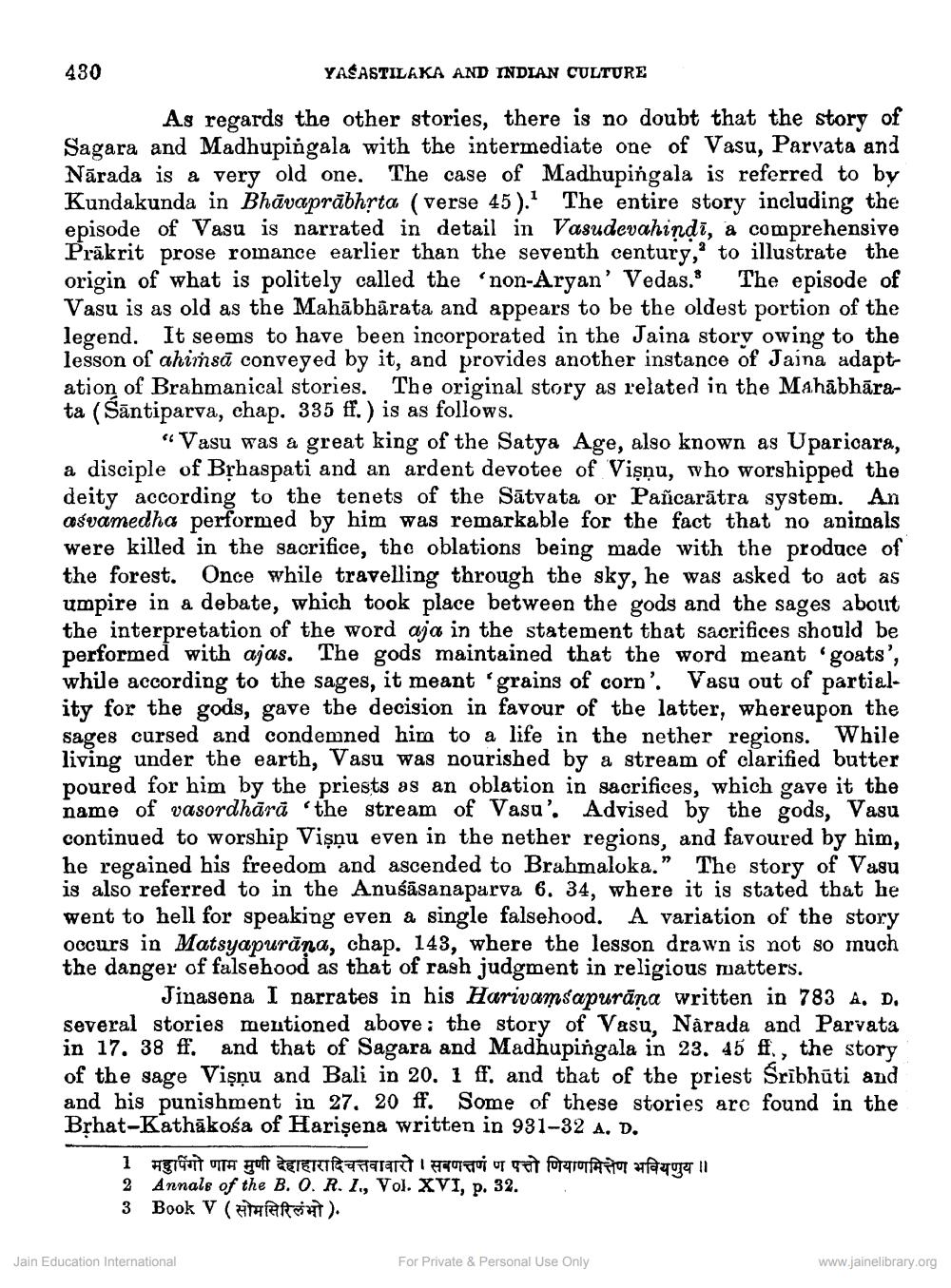________________
430
YASASTILAKA AND INDIAN CULTURE
As regards the other stories, there is no doubt that the story of Sagara and Madhupingala with the intermediate one of Vasu, Parvata and Nārada is a very old one. The case of Madhupingala is referred to by Kundakunda in Bhāvaprābhrta (verse 45). The entire story including the episode of Vasu is narrated in detail in Vasudevahindi, à comprehensive Prākrit prose romance earlier than the seventh century, to illustrate the origin of what is politely called the 'non-Aryan' Vedas.* The episode of Vasu is as old as the Mahābhārata and appears to be the oldest portion of the legend. It seems to have been incorporated in the Jaina story owing to the lesson of ahiṁsā conveyed by it, and provides another instance of Jaina adaptation of Brahmanical stories. The original story as related in the Mahābhārata (śāntiparva, chap. 335 ff.) is as follows.
“Vasu was a great king of the Satya Age, also known as Uparioara, a disciple of Brhaspati and an ardent devotee of Vişņu, who worshipped the deity according to the tenets of the Sātvata or Pañcarātra system. An asvamedha performed by him was remarkable for the fact that no animals were killed in the sacrifice, the oblations being made with the produce of the forest. Once while travelling through the sky, he was asked to aot as umpire in a debate, which took place between the gods and the sages about the interpretation of the word aja in the statement that sacrifices should be performed with ajas. The gods maintained that the word meant goats', while according to the sages, it meant 'grains of corn'. Vasu out of partiality for the gods, gave the decision in favour of the latter, whereupon the sages cursed and condemned him to a life in the nether regions. While living under the earth, Vasu was nourished by a stream of clarified butter poured for him by the priests as an oblation in sacrifices, which gave it the name of vasordhārā 'the stream of Vasu'. Advised by the gods, Vasu continued to worship Vişņu even in the nether regions, and favoured by him, he regained his freedom and ascended to Brahmaloka." The story of Vasu is also referred to in the Anusāsanaparva 6. 34, where it is stated that he went to hell for speaking even a single falsehood. A variation of the story occurs in Matsyapuräna, chap. 143, where the lesson drawn is not so much the danger of falsehood as that of rash judgment in religious matters.
Jinasena I narrates in his Harivamsapurāna written in 783 A. D. several stories mentioned above; the story of Vasu, Narada and Parvata in 17. 38 ff. and that of Sagara and Madhupingala in 23. 45 ff, the story of the sage Vişnu and Bali in 20. 1 ff. and that of the priest Sribhūti and and his punishment in 27. 20 it. Some of these stories are found in the Brhat-Kathākośa of Harişena written in 931-32 A, D.
1 महापंगो णाम मुणी देहाहारादिचत्तवावारो । सबणत्तणं ण पत्तो णियाणमित्तेण भवियणुय । 2 Annals of the B. 0. R. I., Vol. XVI, p. 32. 3 Book V (
H RT).
Jain Education International
For Private & Personal Use Only
www.jainelibrary.org




